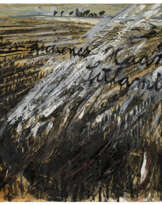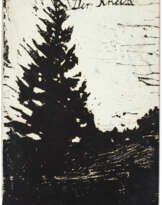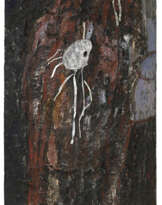ID 813888
Lot 139 | Anselm Kiefer (né en 1945)
Estimate value
€ 80 000 – 120 000
Aperiatur Terra
titré ''aperiatur terra'' (en haut à droite)
terre, huile, émulsion et collage d'un épi de blé sur carton monté sur panneau
63 x 88 cm.
Réalisé en 2004.
titled ''aperiatur terra'' (upper right)
soil, oil, emulsion, wheat ear glued on cardboard mounted on panel
24 3/4 x 34 5/8 in.
Executed in 2004.
Provenance
Galerie Yvon Lambert, Paris
Acquis auprès de celle-ci en 2004
Special notice
Artist's Resale Right ("droit de Suite").
If the Artist's Resale Right Regulations 2006 apply to this lot, the buyer also agrees to pay us an amount equal to the resale royalty provided for in those Regulations, and we undertake to the buyer to pay such amount to the artist's collection agent.
Post lot text
« Je m'utilisais comme le héros d'un mythe ou d'une révolution imaginée. C'est humoristique, pathétique, mais c'est une partie importante de la recherche sur qui nous sommes dans cet univers. Nous sommes capables depenser très haut et très bas. Il est plus difficile de se situer entre le cie let la terre ». - Anselm Kiefer
"I was using myself as the hero of an imagined myth or revolution. It is humorous, pathetic, but it is an important part of researching about who we are in this universe. We are capable of thinking very high and very low. Placing ourselves between heaven and earth is more difficult.'' - Anselm Kiefer
« Pour survivre, je crée un sens, et c'est mon art. Je le crée là où se croisent des lignes horizontales et verticales qui traversent l'espace : des lignes historiques, des géologiques, des astrales. Il me faut être là où elles se rencontrent, où elles se touchent. Il y a des ondes aussi [...]. Et je prétends que l'artiste les rend visibles, dans une petite part ». - Anselm Kiefer
“To survive, I create meaning, and this is my art. I create it where horizontal and vertical lines intersect while traveling through space: historical lines, geological lines, astral lines. I must be where they meet, where they touch. […] And I claim that the artist makes them visible, in a small way.” - Anselm Kiefer
La démarche artistique d’Anselm Kiefer gravite autour de la mémoire collective. Elle fait référence aux symboles et aux sédiments de l’histoire, qu’ils soient politiques, religieux, mythologiques, philosophiques ou littéraires, présentés dans des compositions sculpturales riches et complexes. Sa technique consiste notamment à superposer la peinture, la terre et les débris, faisant de ses toiles des espaces géologiques qui relèvent autant de la décomposition que de la création. Les matériaux naturels et bruts qu’il édifie en majesté lui servent de transition entre plusieurs médiums. Ses œuvres passent par exemple de la peinture à la sculpture, ou de la photographie à l'installation. La jonction entre les matériaux, les thèmes, et son obsession pour l’assemblage, le désassemblage, la construction et la destruction confèrent aux œuvres de Kiefer une dimension sublime, dans le sens que donne l’histoire de l’art à ce mot : ses toiles sont édifiantes, texturées, singulières, hybrides et vivantes. Observer une œuvre de Kiefer n’est pas qu’une expérience visuelle intense, c’est également une confrontation radicale aux symboles du passé.
Ce mélange de références et de matières est parfaitement illustré dans Aperiatur Terra. Le titre de l’œuvre fait référence à la prophétie d’Isaïe. Elle se traduit par "que la terre s’ouvre" et continue "et pousse un sauveur et que la justice germe en même temps". Elle suggère l'équilibre entre la mort et la résurrection, la décadence et la recréation, deux composantes emblématiques dans l'œuvre de Kiefer. La surface d’Aperiatur Terra porte des traces de modelages aux tons terracotta ; ils engendrent une géologie singulière et primitive. Cette étendue de matière brute et façonnée à la main, plus ou moins volumineuse, fait écho à une terre hostile et sèche, prête à craqueler sous les pas des passants, au bord du chaos. La terre est sur le point de s’ouvrir. La puissance visuelle, la symbolique et l’équilibre des matières font de l’artiste l’un des plus grands poètes visuels du XXème siècle.
Anselm Kiefer's artistic approach revolves around collective memory. He refers to the symbols and sediments of history, whether political, religious, mythological, philosophical or literary, presented in rich and complex sculptural compositions. His technique includes layering paint, earth and debris, making his paintings geological spaces that are as much about decomposition as they are about creation. The natural and raw materials he builds up in majesty serve as a transition between several mediums. His works move, for example, from painting to sculpture, or from photography to installation. The juxtaposition of materials and themes, and his obsession with assembly, disassembly, construction and destruction, give Kiefer's works a sublime dimension, in the historical art sense of the word: his canvases are uplifting, textured, singular, hybrid and alive. Looking at Kiefer's work is not only an intense visual experience, it is also a radical confrontation with symbols of the past.
This mixture of references and materials is perfectly illustrated in Aperiatur Terra. The title of the work refers to Isaiah's prophecy. It translates as 'let the earth open' and continues 'and let a saviour grow and justice spring up at the same time'. It suggests the balance between death and resurrection, decay and re-creation, both of which are emblematic of Kiefer's work. The surface of Aperiatur Terra bears traces of terracotta-toned modelling; they engender a singular, primitive geology. The expanse of raw, hand-formed material, varying in size, echoes a hostile, dry earth, ready to crack under the footsteps of passers-by, on the brink of chaos. The earth is about to open up. The visual power, symbolism and balance of the materials make the artist one of the greatest visual poets of the 20th century.
| Artist: | Anselm Kiefer (1945) |
|---|---|
| Art style: | Contemporary art |
| Place of origin: | Western Europe, Germany, Europe |
| Auction house category: | Paintings |
| Artist: | Anselm Kiefer (1945) |
|---|---|
| Art style: | Contemporary art |
| Place of origin: | Western Europe, Germany, Europe |
| Auction house category: | Paintings |
| Address of auction |
CHRISTIE'S 9 Avenue Matignon 75008 Paris France | ||||||||||||||
|---|---|---|---|---|---|---|---|---|---|---|---|---|---|---|---|
| Preview |
| ||||||||||||||
| Phone | +33 (0)1 40 76 85 85 | ||||||||||||||
| Fax | +33 (0)1 40 76 85 86 | ||||||||||||||
| Conditions of purchase | Conditions of purchase | ||||||||||||||
| Shipping |
Postal service Courier service pickup by yourself | ||||||||||||||
| Payment methods |
Wire Transfer | ||||||||||||||
| Business hours | Business hours
|











